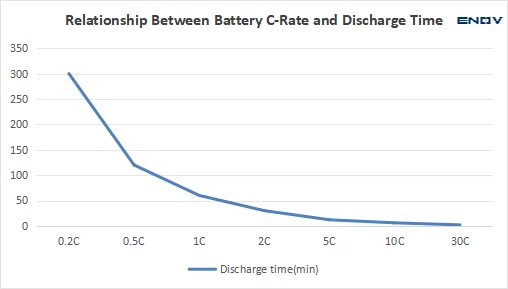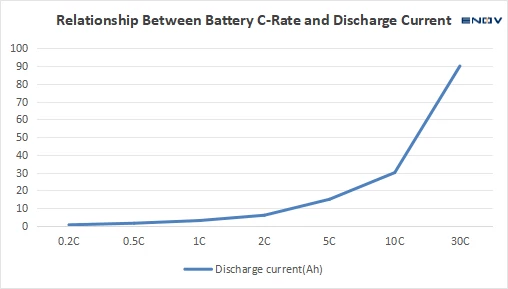What is the C-Rate of a Starter Battery and How to Calculate It?

Rayne Zhou
Account Manager
Customer Service | Launching Battery Marketing Project Management | Regular Content Updates| Search Engine Optimization
In the world of batteries, the C-rate is an extremely crucial concept, especially for starter batteries. It serves as the “speed indicator” of a battery, profoundly influencing the battery’s performance in various scenarios. So, what exactly is the C-rate of a starter battery, and how is it calculated? Next, we will delve into the secrets behind it.
I. Definition and Operating Principle of C-Rate
The C-rate represents the charging and discharging rate of a battery. It is the ratio of current to the battery’s rated capacity, with the capacity typically measured in ampere-hours (Ah). Simply put, a 1C rate means the battery can discharge its full rated capacity within one hour. For example, for a battery with a capacity of 10Ah, 1C represents a continuous discharge current of 10 amperes (10A) for 1 hour.
Other C-rate scenarios are as follows: At a 2C rate, the battery can provide a current twice its capacity within half an hour. For instance, a 10Ah battery discharges continuously at 20A for 30 minutes. At a 0.5C rate, the battery takes two hours to fully discharge its capacity, just like a 10Ah battery discharging at 5A for 2 hours. In this way, the C-rate becomes a standardized indicator for measuring the charging and discharging speed of a battery.
II. Importance of C-Rate for Starter Batteries
1) Meeting the High Current Demand for Engine Starting
When engines of motorcycles, cars, and other vehicles start, they require a strong current surge. Taking motorcycles as an example, the starter has an extremely high demand for power (current) at the moment of starting the engine, especially in cold environments. At this time, the C-rate of the starter battery plays a decisive role.
2) Ensuring Power Output During Starting
A battery with a high C-rate can provide a strong current in a short period, and its voltage will not drop significantly during the discharge process. This is crucial for ensuring the normal operation of the starter motor and the smooth starting of the engine. If the battery has a low C-rate and cannot provide sufficient current, it may lead to difficulty in starting the engine or even failure to start.
3) Trade-off Between Capacity and C-Rate
It should be noted that batteries with a high C-rate are usually designed to focus on fast and high-power discharge. Therefore, compared with low C-rate batteries, their total energy capacity may be lower. However, in the application scenario of starter batteries, being able to provide a strong starting current in a short time is more important than pursuing long-term endurance. Hence, starter batteries tend to prioritize a high C-rate design.
III. Methods for Calculating the C-Rating
1) Basic Formula
The C-rating of a battery can be calculated using a simple formula: T = 1 / Cr (when viewed in hours) or T = 60 minutes / Cr (when viewed in minutes), where T represents time and Cr represents the C-rate.
2) Specific Examples and Chart Display
Table: Discharge Parameters of a 3000mAh Battery at Different C-Rates
C-Rate | Discharge Current (A) = C-Rate × 3Ah | Theoretical Discharge Time (minutes) = 60 / C-Rate | Reference for Practical Application Scenarios |
0.2C | 0.6 | 300 | Long-term power supply for low-speed equipment (e.g., small sensors) |
0.5C | 1.5 | 120 | Endurance power supply for ordinary electronic devices (e.g., portable instruments) |
1C | 3.0 | 60 | Standard discharge for conventional equipment (e.g., small emergency lights) |
2C | 6.0 | 30 | Medium-speed power demand (e.g., short-term flight of small drones) |
5C | 15.0 | 12 | High power demand (e.g., remote-controlled racing cars) |
10C | 30.0 | 6 | High-power short-term discharge (e.g., emergency starting assistance) |
30C | 90.0 | 2 | Ultra-high-rate discharge (e.g., instantaneous starting of professional equipment) |
Figure: Relationship Between C-Rate and Discharge Time of a 3000mAh Battery

Chart Description: The X-axis represents the C-rate (0.2C – 30C), and the Y-axis represents the discharge time (minutes). It can be intuitively observed from the chart that as the C-rate increases gradually from 0.2C to 30C, the discharge time decreases rapidly from 300 minutes to 2 minutes, showing a strict inverse proportional relationship, which is completely consistent with the results of the theoretical calculation formula.
Figure: Relationship Between C-Rate and Discharge Current of a 3000mAh Battery

Chart Description: The X-axis represents the C-rate (0.2C – 30C), and the Y-axis represents the discharge current (amperes). The line trend shows that as the C-rate increases by one level, the discharge current increases linearly simultaneously. For example, the current is 3A at 1C and reaches 30A at 10C. This clearly reflects the calculation logic of “discharge current = C-rate × battery capacity (Ah)” and also explains why high C-rate batteries can meet the high current demand in starting scenarios.
From the above Excel charts, it can be further verified that the C-rate is a core indicator for balancing the battery’s discharge speed and duration. In the application of starter batteries, priority should be given to the current output capability under high C-rates (such as 15A – 30A current corresponding to 5C – 10C) rather than long endurance under low rates. This is highly consistent with the core demand of “instantaneous high power” when starting cars and motorcycles.
IV. C-Rate Characteristics of Different Battery Chemical Compositions
Starter batteries with different chemical compositions have different C-rate performances. For example, lead-acid batteries are usually rated at a very low discharge rate, commonly 0.05C or 20-hour rate. This is because the internal chemical reaction of lead-acid batteries will be affected under high discharge rates, resulting in reduced capacity and shortened service life.
Lithium batteries, on the other hand, have high C-rate potential and can withstand much higher discharge C-rates than other chemical batteries, such as lead-acid batteries. In some high-performance starter lithium batteries, the discharge C-rate can even reach several tens of C, which makes lithium batteries gradually emerge in the field of starter batteries, especially in scenarios with extremely high requirements for starting performance.
Another example is nickel-metal hydride (Ni-MH) batteries, whose C-rate is usually around 0.5C, at a relatively medium level. Different battery chemical compositions determine their unique C-rate ranges due to differences in internal structure and chemical reaction mechanisms, thus making them suitable for different application scenarios.
V. Application Scenarios Requiring High C-Rates
In modern society, more and more application scenarios have requirements for the high C-rate performance of batteries. In addition to the starter batteries of motorcycles and cars, many other fields also rely on high-C-rate batteries.
In the industrial field, some emergency starting power supplies need to provide strong electric power in a short time to start large-scale equipment or provide backup power for key systems. Such emergency starters often require a discharge rate of up to 80C to meet their demand for rapid power supply in emergency situations.
In the consumer electronics field, devices such as remote-controlled models, drones, and robots also have high requirements for the high C-rate performance of batteries. During operation, these devices need to frequently perform actions such as acceleration and steering, which requires the battery to provide a large current in an instant to meet the high power demand of the motor. For example, in the remote control industry, the discharge rate of some high-rate discharge batteries can reach 50C to ensure that remote-controlled devices can quickly respond to operation commands and achieve precise control.
The C-rate of a starter battery is a key factor affecting its performance. By understanding the definition, operating principle, calculation method of the C-rate, and the C-rate characteristics of different battery chemical compositions, we can better select and use starter batteries to meet the needs of various application scenarios. Whether in the vehicles we use for daily travel or in the high-tech remote-controlled devices, the C-rate plays an important role silently, bringing convenience to our lives and work.
Subscribe for Real-Time Industry Updates
Stay ahead with real-time, ad-free industry insights delivered straight to your inbox!


Rayne Zhou
Account Manager
Customer Service | Launching Battery Marketing Project Management | Regular Content Updates| Search Engine Optimization
.webp)